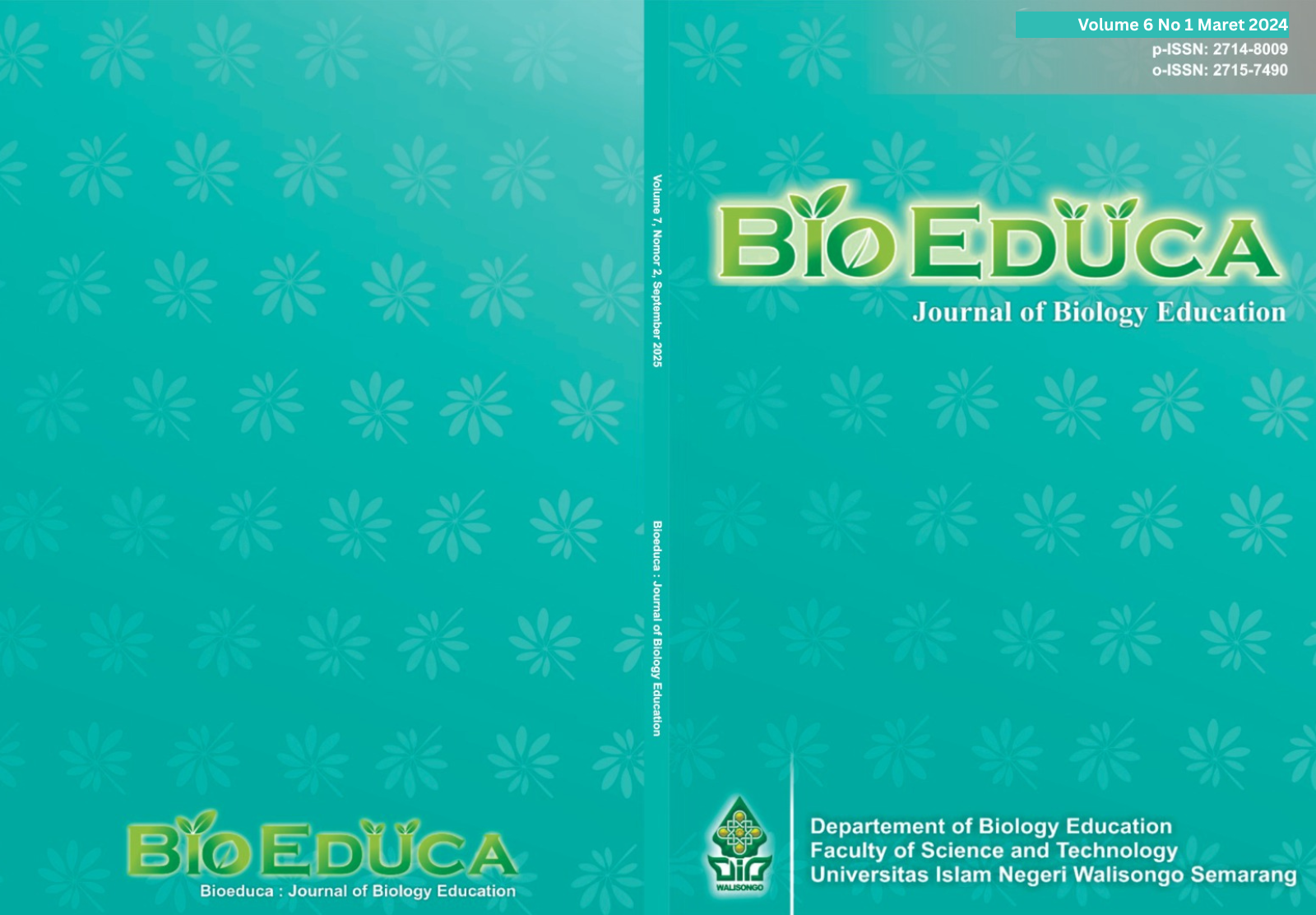Validation of Popular Scientific Books on the Results of Morphological and Anatomical Characterization of Binjai (Mangifera caesia Jack.)
Main Article Content
Abstract
Downloads
Article Details
The copyright of the received article shall be assigned to the journal as the publisher of the journal. The intended copyright includes the right to publish the article in various forms (including reprints). The journal maintains the publishing rights to the published articles. Authors are allowed to use their articles for any legal purposes deemed necessary without written permission from the journal with an acknowledgment of initial publication to this journal.

This work is licensed under a Creative Commons Attribution-ShareAlike 4.0 International License.
References
Akbar, S. (2022). Instrumen Perangkat Pembelajaran. Bandung: Remaja Rosdakarya.
Dewi, N.R., & Arini, F.Y. (2018). Uji Keterbacaan pada Pengembangan Buku Ajar Kalkulus Berbantuan Geogebra untuk Meningkatkan Kemampuan Pemecahan Masalah dan Representasi Matematis. Prisma (Prosiding Seminar Nasional Matematika), 299-303.
Hasanah, U., Azis, P.A., Jayati, R.D., Astute, W.W., Taskirah, A., Liana, A., Rusmidin, Nopiyanti, N., Lutfi, Veryani, A.N., Samsi, A.N., Vertigo, S., Banna, M.Z.A., & Sulastri, N.D.P. (2021). Anatomi dan Fisiologi Tumbuhan. Bandung: Media Sains Indonesia.
Ibrahim, M., & Subali, B. (2017). Pengembangan Bahan Ajar & Pengembangan Instrument Pengukuran Pembelajaran Biologi. Banjarmasin: ULM Press.
Latifah, N., Dharmono, & Zaini, M. (2020). Validasi Buku Ilmiah Populer Keanekaragaman Spesies Famili Anacardiaceae untuk Meningkatkan Keterampilan Berpikir Kritis Mahasiswa. Quantum, 11(2), 196-210.
LIPI (Lembaga Ilmu Pengetahuan Indonesia). (2019). Panduan Penelaahan & Penilaian Naskah Buku Ilmiah. Jakarta: LIPI Press.
Nurfatma, Dharmono, & Aminarti, S. (2020). Validasi Buku Ilmiah Populer Etnobotani Tumbuhan Leucosyke capitellata di Kawasan Hutan Bukit Tamiang Kabupaten Tanah Laut. Wahana-Bio, 12 (2), 113-122.
Plomp, T., Nieveen, N., Akker, J.V.D, Bannan, B., & Kelly, A.E. (2007). An Introduction to Educational Design Research. Proceedings of The Seminar Conducted at The East China Normal University, November 23-26. Shanghai (PR China).
Putri, A.I., Dharmono, & Zaini, M. (2020). Validitas Buku Ilmiah Populer Keanekaragaman Spesies Family Fabaceae dalam Meningkatkan Keterampilan Proses Sains Mahasiswa. Quantum, 11(2), 186-195.
Rai, I. N, Wijana, G., & Semarajaya, C. G. A. (2008). Identifikasi Variabilitas Genetik Wani Bali (Mangifera caesia Jack.) dengan Analisis Penanda RAPD. Hort, 18(2), 125-134.
Rakedzon, T, & Baram-Tsabari, A. (2017). To Make a Long Story Short: a Rubric for Assessing Graduatestudents’ Academic and Popular Science Writing Skills. Assessing Writing, 32, 28–42.
Rusdi, M. (2018). Penelitian Desain dan Pengembangan Kependidikan: Konsep, Prosedur, dan Sintesis Pengetahuan Baru. Jakarta: Rajawali Pers.
Sari, D.S. (2019). Pengembangan Buku Populer Pembuatam Yoghurt Kulit Pisang sebagai Media Pembelajaran berbasis Entrepreneurship di Lembaga Pembinaan Khusus Anak Provinsi Jambi. Skripsi tidak dipublikasikan. Jambi: Universitas Jambi.
Setyosari, P. (2010). Metode Penelitian Pendidikan dan Pengembangan. Jakarta: Kencana.
Sintia, Zaini, M., & Halang, B. (2021). Validitas Buku Ilmiah Populer Tumbuhan Aren (Arenga pinnata Merr.). JIPB, 2(1), 30-37.
Sugiyono. (2017). Metode Penelitian Kuantitatif, Kualitatif, dan R&D. Bandung: Alfabeta.
Zaini, M. (2018). Penelitian Desain Pendidikan Aplikasi Teori ke Dalam Praktik. Jakarta: Penebar Media Pustaka.

